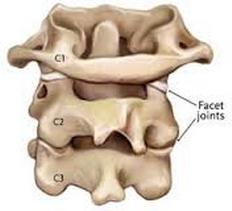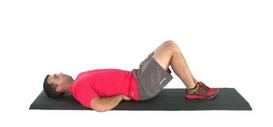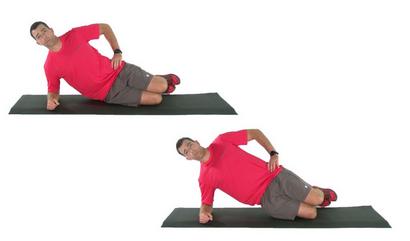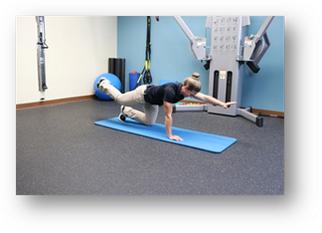Got Low Back Pain?

For so many of us the question is not: Do you have back pain? The better question - the more specific question - that we need to answer is: What kind of back pain do you have?
This article is 5th in a series of articles on various sources of low back pain.
So far we have covered:
- Part 1: Protecting Your Back From Pain: How to Sit, Stand, Move and Work to Prevent Back Pain
- Part 2: Lumbar Strains and Sprains
- Part 3: Lumbar Stenosis
- Part 4: Lumbar Disc Disorders: Bulging or Herniated Discs
What’s next?
Facet syndrome
It’s true. You may not have heard of facet joint syndrome. But it is the cause of some of the most common recurring and disabling low back and neck problems. It can cause great pain and even disability in those who don’t get treatment.
What Are Facet Joints and Where Are They?

Facet joints are the connection between the vertebral arch of one vertebra to the arch of the adjacent vertebra. These small joints in the back of the spine are responsible for much of the back’s rotational movement and they limit side-to-side movement.
What’s Happening in Facet Joint Syndrome?
The area between the vertebrae - the joints between the spine bones - degenerate. The cartilage inside the facet joint breaks down and becomes inflamed, much like an arthritic condition. The inflammation sends pain signals through the nearby nerve endings and you feel it as back pain beginning at the spinal joint.
Third of Cases in Low Back
Over half of facet syndrome cases occur in the neck (cervical spine), and a third occurs in the low back (lumbar spine).
Motion Related
The pain is often worse when moving from a sitting position to a standing position or moving from a bent-over position back to an upright standing position.
Recurring and Variable Pain
The instance of facet syndrome is episodic. It reoccurs unpredictably and can increase or decrease in pain.
Sitting Increases Pain
Standing can be uncomfortable and necessarily limited, but sitting can be unbearable. At the height of pain and disability, muscle spasms are continual, fatiguing the muscle, which repeats the cycle.
What Causes Facet Syndrome?
- Strain from overuse - sports or work overuse
- Whiplash from a car accident
- Pre-existing arthritis
- Prolonged sitting
- Excess weight
How Can I Prevent Facet Syndrome?
Managing the symptoms of facet syndrome is a challenge. Medication, physical therapy, joint injections, nerve blocks, and nerve ablations are potential treatments. If the condition becomes chronic, surgery to fuse the affected joint may be required.
But, you can protect yourself from many of the causes listed above!
Consider this:
Do you think you have weak core muscles? Many sufferers of facet syndrome have weak core muscles. Particularly, they often have weak stabilizing paraspinal muscles.

But, guess what? These can be strengthened.
Do you have a desk job and sit for most of the day? Sitting all day often leads to poor sitting posture.
If this describes your daily life, the muscles that support your spine and keep it stable are probably weakened. All of these factors contribute to the condition, but these are factors that you can do something about.
What Can I Do to Strengthen My Core?
The importance of a strong core and training your spinal muscles cannot be overstated in its importance for preventing a host of back problems, including facet joint syndrome.
Do these Four Core Exercises
When you are in acute pain or recovering from acute pain the core exercises you choose to do are important. Not every core and lower back exercise is appropriate because of the load it puts on the spine.
These four exercises, when done carefully - and stopping if in pain - can slowly rebuild lower back muscles and core stability.
Abdominal Curl-Up
The abdominal curl-up has a good ratio of muscle activation to spine load.


- Keep the spine in a neutral position.
- Lie flat on the back with knees bent and feet flat on the floor.
- Put your hands flat under the small of your back to watch for pressure on them - try to not put pressure on them with your lower back.
- Do not curl the head or neck. Tuck the chin slightly to avoid jutting the chin forward or tightening the neck.
- Lift the head and shoulders as if to the ceiling.
- Hold for 4-8 seconds as comfortable. Work up to doing 6-8 reps and 2 to 3 sets.
Side Bridge From Knees
- Start from a side position, knees bent 90 degrees with legs behind you, resting on the hip, thigh, and bent arm.
- Rest the other hand on the other hip for balance.
- Lift the hips off the ground to straighten the line from head to knees. Hold, tucking pelvis under slightly, bracing abdominals, for 10 seconds and try for 6 reps.
- Increase time and reps as you grow in strength.

Bird Dog
- Begin on your hands and knees in a quadruped position.

- While abdominally bracing, slowly extend your right leg and left arm into a fully straightened “bird dog” position.

- Hold this contraction for two seconds before returning to touch your right hand to your left knee and repeating for ten repetitions before switching sides.
- Keep your abdominals engaged the entire time and do not arch your back or twist your hips at any point.
Glute Bridge
- Lay on your back on an exercise mat or the floor in a bent-knee position with your feet flat on the floor.
- Place your feet hip-width apart with the toes facing slightly away from you.
- Gently contract your abdominal muscles to flatten your low back into the floor. Attempt to maintain this gentle muscle contraction throughout the exercise.

- Gently exhale. Keep the abdominals engaged and pressing through your heels, lift your hips up off the floor until your body is in a straight line between your knees and shoulders.
- Avoid pushing your hips too high, which can cause hyperextension (arching) in your low back.
- Lowering Phase: Inhale and slowly lower yourself back to your starting position.
Lifestyle Changes
If your pain is from a problem related to overuse, poor posture or improper exercise, there are steps that you can take to help avoid these injuries from happening. The more you improve your postural habits, the more you can reduce the bad effects of sitting on the spine - namely PAIN.
Good Posture
Keeping the normal curvature of the spine during daily activities is essential. Some ideas to help support your spine are:
- Pull the car seat forward to protect the low back.
- Use a Stool or Open Cabinet. When standing at a sink, put one foot up on a ledge, keeping that knee bent, will relieve the lower back and help you keep proper posture.
- Practice the Pelvic Tilt. When standing, practice tilting the pelvis “under” by squeezing or pinching the buttocks together and pulling the belly button into the spine. Hold this position for several seconds and repeat often. You are strengthening core muscles and preventing an excessive arch in the lower back.
Read the first post in this series on lower back pain
Protecting Your Back From Pain: How to Sit, Stand, Move and Work to Prevent Back Pain. It has numerous tips for maintaining good posture during a variety of daily activities.
In Pain?
Use heat (e.g. heat wraps, a hot water bottle, hot showers) or cold (e.g. cold pack applications) to help alleviate pain during an episode.

Can a Chiropractor Help With My Back Pain?
They definitely can. Our chiropractors can help return mobility and neuromuscular function to your back joints. This will help relieve you of pain and allow you to implement a sound stretching and exercise program.
At Daniels Chiropractic we can get your spine back into its normal position and increase its mobility. Then you can follow these tips and begin to see improvement. We can also design a custom stretching and exercise plan for you to practice at home.
We are committed to helping you feel, move, and live better. We want to help you get better. So, give us a call at 262.638.9999 to make an appointment.
Daniels Chiropractic Office
2609 Rapids Drive
Racine, WI 53404
Phone: 262.638.9999
Fax: 262.638.0742
Sources:
This article produced with the help of the Chiropractic Success Academy.
Image Sources:
- https://myrehabconnection.com/curl-up-progressions/
- https://myrehabconnection.com/side-bridge-progressions/
